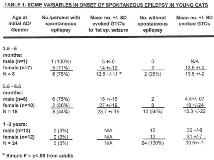INTERACTIONS BETWEEN AGE AND GENDER IN FELINE DEVELOPMENTAL TEMPORAL LOBE EPILEPSY
Abstract number :
2.098
Submission category :
Year :
2003
Submission ID :
3731
Source :
www.aesnet.org
Presentation date :
12/6/2003 12:00:00 AM
Published date :
Dec 1, 2003, 06:00 AM
Authors :
Margaret N. Shouse, John C. Scordato, Chris Angara, Paul R. Farber Sleep Disturbance Research, VAGLAHS, North Hills, CA; Neurobiology & BRI, UCLA, Los Angeles, CA
This report updates findings on developmental temporal lobe epilepsy in amygdala-kindled cats with reference to factors of age at initial afterdischarge (AD), gender and number of elicited convulsions.
Fifty cats were kindled to stage 6 or generalized tonic-clonic convulsions (GTCs) via daily electrical stimulation of amygdala (1 sec train of 60 HZ biphasic square waves) and had a varying number of stimulus evoked GTCs afterward. Data were evaluated for incidence of any spontaneous, generalized seizures after kindling (multifocal EEG seizure discharge with clinically evident seizures, e.g., lip-smacking, tonic-clonic convulsions) as a function of age at initial AD, gender and number of elicited GTCs after kindling.
Table 1 summarizes some of the main findings. Youngest pre-adolescent animals (2.5-5 months at initial AD) were more likely to develop spontaneous seizures after kindling (6 of 8 or 75%) than older pre-adolescents (5.5-6.5 months old at initial AD; 8 of 14 or 44%), especially when compared to adults from 1-3 years old at initial AD (0 of 24 or 0%). Youngest cats required the fewest number of elicited GTCs prior to onset of spontaneous epilepsy. Youth as a precipitating factor seemed most important in pre-adolescent females since younger age at initial AD correlated with rapid post-kindling onset latency to spontaneous seizures (r= p [lt] .01). Older pre-adolescent males also required few elicited GTCs prior to onset of spontaneous seizures and were much more likely than females of the same age to become spontaneously epileptic (75% vs. 20 %). Addition of more males to the youngest group and of more evoked GTCs in females of the older pre-adolescent group are needed to confirm these trends.
Age, gender and possibly number of evoked GTCs interact to provoke spontaneous seizures in amygdala kindled, pre-adolescent cats.[figure1]
[Supported by: Department of Veterans Affairs]
